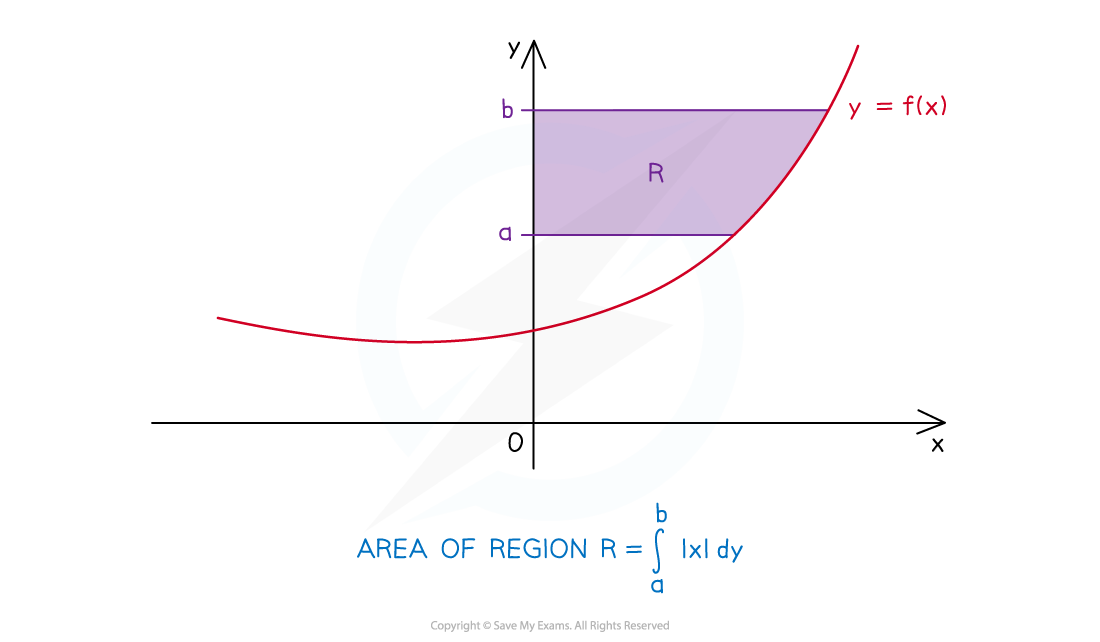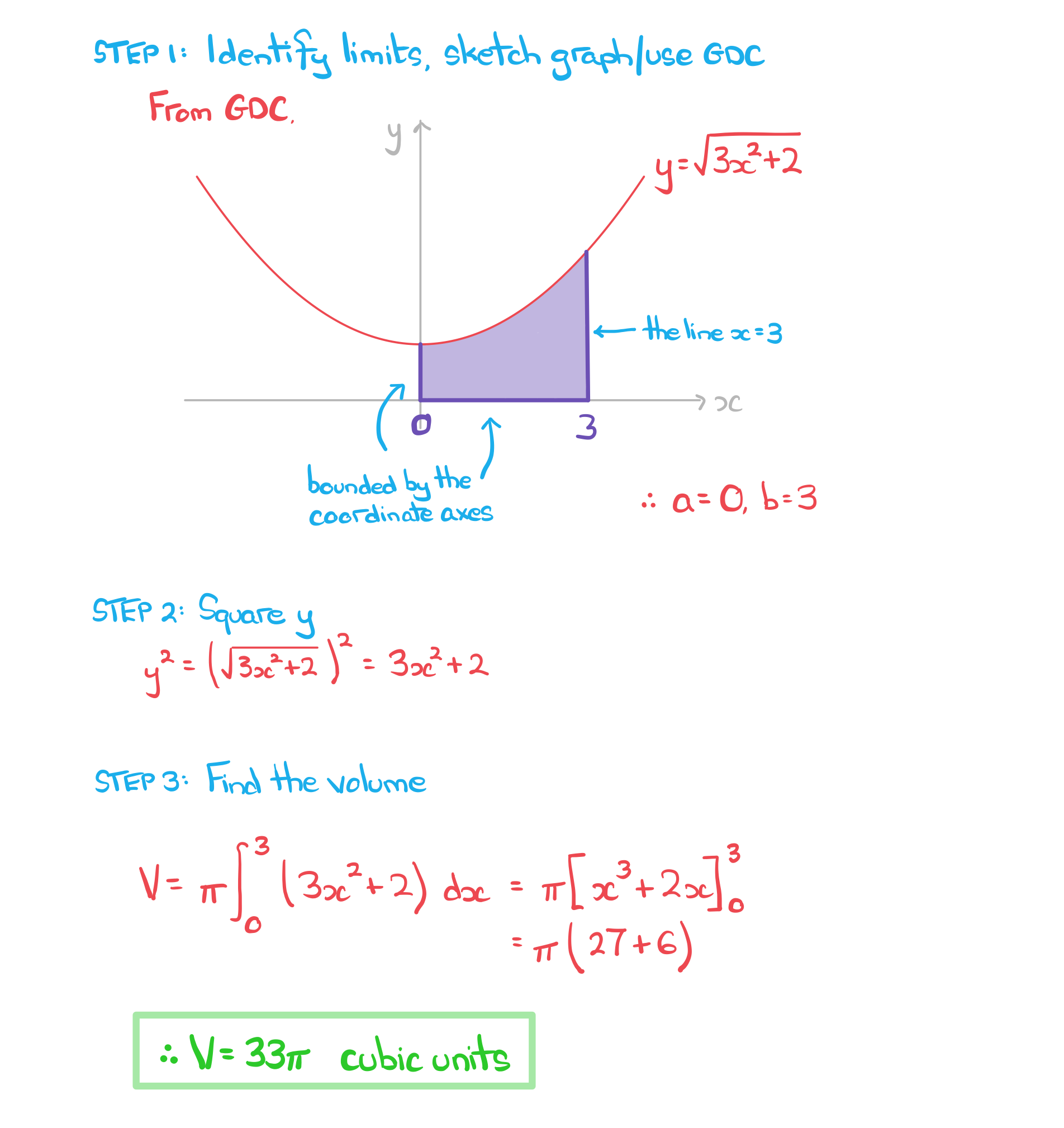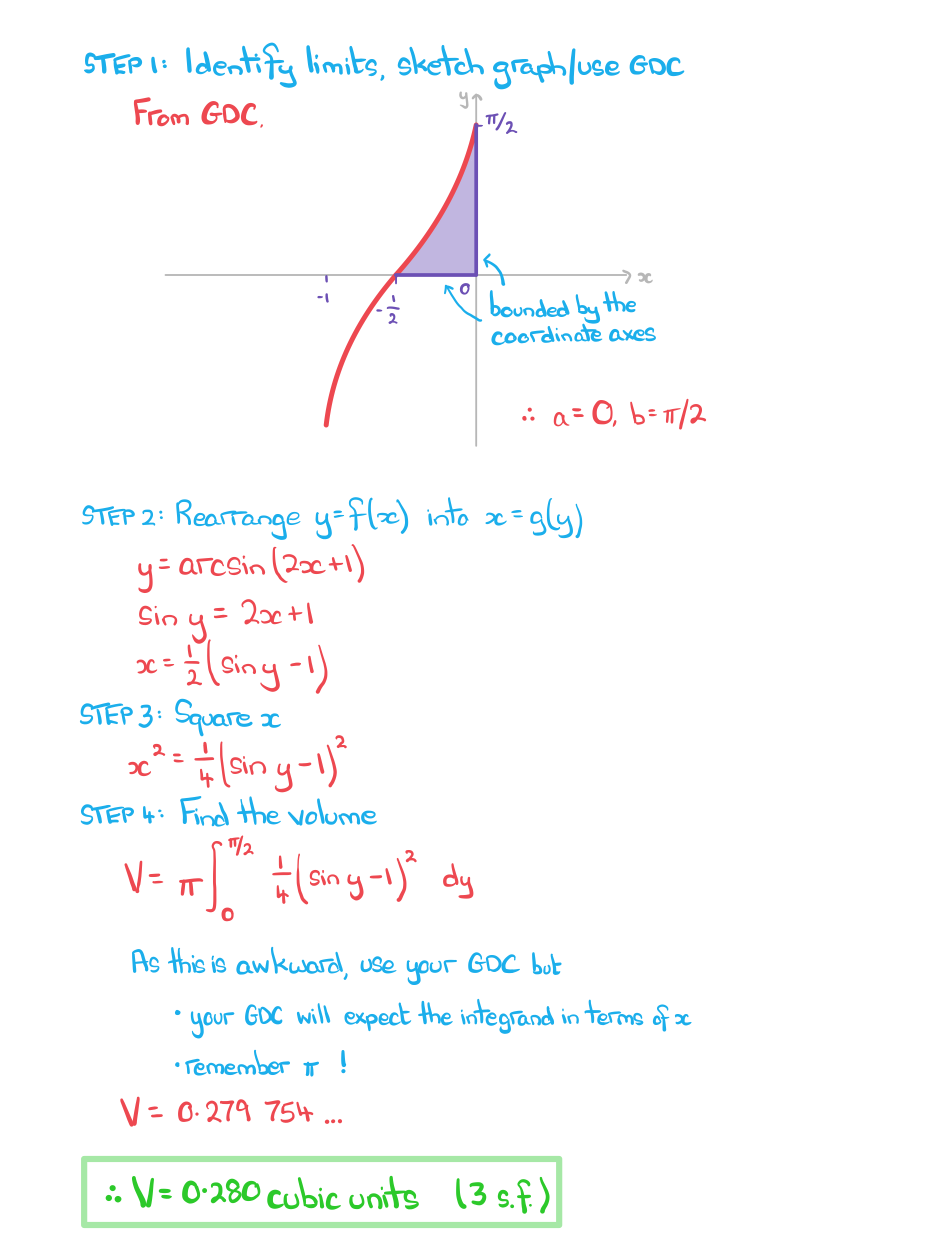Area Between Curve & y-axis
What is meant by the area between a curve and the y-axis?

- The area referred to is the region bounded by
- the graph of
- the
-axis
- the horizontal line
- the horizontal line
- The exact area can be found by evaluating a definite integral
- The graph of
could be a straight line
- using basic shape area formulae may be easier than integration
- e.g. area of a trapezium:
How do I find the area between a curve and the y-axis?
- Use the formula
- This is given in the formula booklet
- The function is normally given in the form
- so will need rearranging into the form
and
may not be given directly as could involve the
-axis (
) and/or a root of
- use a GDC to plot the curve, sketch it and highlight the area to help
STEP 1
Identify the limits and
Sketch the graph of or use a GDC to do so, especially if
and
are not given directly in the question
STEP 2
Rearrange into the form
This is similar to finding the inverse function
STEP 3
Evaluate the formula to evaluate the integral and find the area required
If using a GDC remember to include the modulus ( | … | ) symbols around
- In trickier problems some (or all) of the area may be ‘negative’
- this will be any area that is left of the
-axis (negative
-values)
- |
| makes such areas ‘positive’
- a GDC will apply ‘|
|’ automatically as long as the | … | are included
- otherwise, to apply ‘|
|’, split the integral into positive and negative parts; write an integral and evaluate each part separately and add the modulus of each part together to give the total area
- a GDC will apply ‘|
- this will be any area that is left of the
Exam Tip
- Longer problems may require you to rotate an area around both the
-axis and the
-aixs
- Sketch and/or use your GDC to help visualise what the problem looks like
Worked Example
Find the area enclosed by the curve with equation , the
-axis and the horizontal lines with equations
and
.

Volumes of Revolution Around x-axis
What is a volume of revolution around the x-axis?
- A solid of revolution is formed when an area bounded by a function
(and other boundary equations) is rotatedradians
around the
-axis
- The volume of revolution is the volume of this solid
- Be careful – the ’front’ and ‘back’ of this solid are flat
- they were created from straight (vertical) lines
- 3D sketches can be misleading
How do I solve problems involving the volume of revolution around x-axis?
- Use the formula
- This is given in the formula booklet
is a function of
and
are the equations of the (vertical) lines bounding the area
- If
and
are not stated in a question, the boundaries could involve the
-axis (
) and/or a root of
- Use a GDC to plot the curve, sketch it and highlight the area to help
- If
- Visualising the solid created is helpful
- Try sketching some functions and their solids of revolution to help
STEP 1
Identify the limits and
Sketching the graph of or using a GDC to do so is helpful, especially when
and
are not given directly in the question
STEP 2
Square
STEP 3
Use the formula to evaluate the integral and find the volume of revolution
An answer may be required in exact form
Exam Tip
- If the given function involves a square root(s), problems can seem quite daunting
- However, this is often deliberate, as the square root will be squared when applying the Volume of Revolution formula, and should leave the integrand as something more manageable
- Whether a diagram is given or not, using your GDC to plot the curve, limits, etc (where possible) can help you to visualise and make progress with problems
Worked Example
Find the volume of the solid of revolution formed by rotating the region bounded by the graph of , the coordinate axes and the line
by
radians around the
-axis. Give your answer as an exact multiple of
.

Volumes of Revolution Around y-axis
What is a volume of revolution around the y-axis?
- Very similar to above, this is a solid of revolution which is formed when an area bounded by a function
(and other boundary equations) is rotated
radians
around the
-axis
- The volume of revolution is the volume of this solid
How do I solve problems involving the volume of revolution around y-axis?
- Use the formula
- This is given in the formula booklet
- The function is usually given in the form
- so will need rearranging into the form
- so will need rearranging into the form
and
may not be given directly as could involve the
-axis (
) and/or a root of
- Use a GDC to plot the curve, sketch it and highlight the area to help
- Visualising the solid created is helpful
STEP 1
Identify the limits and
Sketching the graph of or using a GDC to do so is helpful, especially if
and
are not given directly in the question
STEP 2
Rearrange into the form
This is similar to finding the inverse function
STEP 3
Square
STEP 4
Use the formula to evaluate the integral and find the volume of revolution
An answer may be required in exact form
Exam Tip
- If the given function involves a square root, problems can seem quite daunting
- This is often deliberate, as the square root will be squared when applying the Volume of Revolution formula and the integrand will then become more manageable
- Whether a diagram is given or not, using your GDC to plot the curve, limits, etc (where possible) can help you to visualise the problem and make progress
Worked Example
Find the volume of the solid of revolution formed by rotating the region bounded by the graph of and the coordinate axes by
radians around the
-axis. Give your answer to three significant figures.

